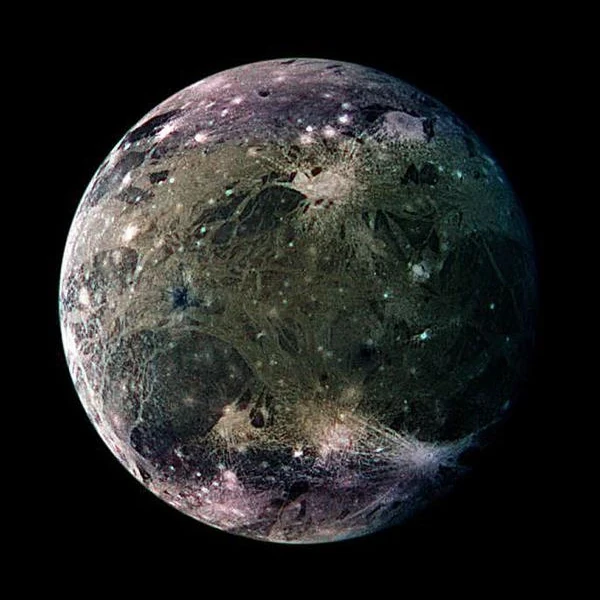
Image: Ganymede is the largest natural satellite of Jupiter and also the largest natural satellite in the solar system. With a diameter of about 5262 kilometers it is the largest object after the Sun and the planets. It was discovered by Galileo in 1610 and is named after the Greek mythological character Ganymede, who was a handsome young man abducted by Zeus to become the divine cup of Olympus.
The solar system is the name given to the planetary system made up of the Sun and the celestial objects orbiting around it. Our solar system has only one star, the Sun. However astronomers have observed that multiple solar systems, with two, three or more stars, are numerous. Without competition, the Sun has become gigantic, it has captured 99.86% of the total mass of dust and gas from the original nebula. Jupiter, the largest planet in the system, captured 71% of the remainder. The other planets have shared the residue of this gravitational evolution.
“A planet is a celestial body which is in orbit around the Sun, which has sufficient mass for its gravity to overcome the cohesive forces of the solid body and maintain it in hydrostatic equilibrium (spherical shape), and which has eliminated any body moving in a near orbit”.
This definition was approved on August 24, 2006, during the 26th General Assembly of the UAI by a show of hands of 400 scientists after ten days of discussions.
| Objects | Characteristic | Average diameter | Ratio/Earth |
| Sun | Star | 1 392 000 km | 109.125 |
| Jupiter | Planet | 142 984 km | 11.208 |
| Saturn | Planet | 120 536 km | 9.449 |
| Uranus | Planet | 51 118 km | 4.007 |
| Neptune | Planet | 49 528 km | 3.882 |
| Earth | Planet | 12 756 km | 1 |
| Venus | Planet | 12 102 km | 0.949 |
| Mars | Planet | 6 796 km | 0.532 |
| Ganymede | Moon of Jupiter | 5 268 km | 0.413 |
| Titan | Moon of Saturn | 5 152 km | 0.404 |
| Mercury | Planet | 4 880 km | 0.382 |
| Callisto | Moon of Saturn | 4 820 km | 0.378 |
| Io | Moon of Jupiter | 3 660 km | 0.286 |
| Moon | Moon of Earth | 3 474 km | 0.273 |
| Europa | Moon of Jupiter | 3 120 km | 0.245 |
| Triton | Moon of Neptune | 2 706 km | 0.212 |
| Eris | Dwarf planet | 2 326 km | 0.364 |
| Pluton | Dwarf planet | 2 306 km | 0.187 |
| Makemake | Dwarf planet | ≈ 1 600 km | 0.250 |
| Titania | Moon of Uranus | 1 577 km | 0.123 |
| Rhea | Moon of Saturn | 1 528 km | 0.119 |
| Oberon | Moon of Uranus | 1 523 km | 0.119 |
| Japet | Moon of Saturn | 1 469 km | 0.115 |
| Charon | Dwarf planet | 1 206 km | 0.095 |
| Umbriel | Moon of Uranus | 1 169 km | 0.092 |
| Ariel | Moon of Uranus | 1 158 km | 0.090 |
| Dione | Moon of Saturn | 1 123 km | 0.088 |
| Tethys | Moon of Saturn | 1 062 km | 0.083 |
| Ceres | Dwarf planet | 974 km | 0.076 |
| Vesta | Asteroid | ≈ 525 km | 0.041 |
| Enceladus | Moon of Saturn | ≈ 504 km | 0.039 |
| Miranda | Moon of Uranus | ≈ 471 km | 0.036 |
| Proteus | Moon of Neptune | ≈ 420 km | 0.033 |
| Mimas | Moon of Saturn | ≈ 396 km | 0.031 |
| Hyperion | Moon of Saturn | ≈ 270 km | 0.021 |
| Phoebe | Moon of Saturn | ≈ 212 km | 0.017 |
| Janus | Moon of Saturn | ≈ 180 km | 0.014 |
| Amalthea | Moon of Jupiter | ≈ 167 km | 0.013 |
| Epimetheus | Moon of Jupiter | ≈ 167 km | 0.013 |
| Prometheus | Moon of Neptune | ≈ 116 km | 0.009 |